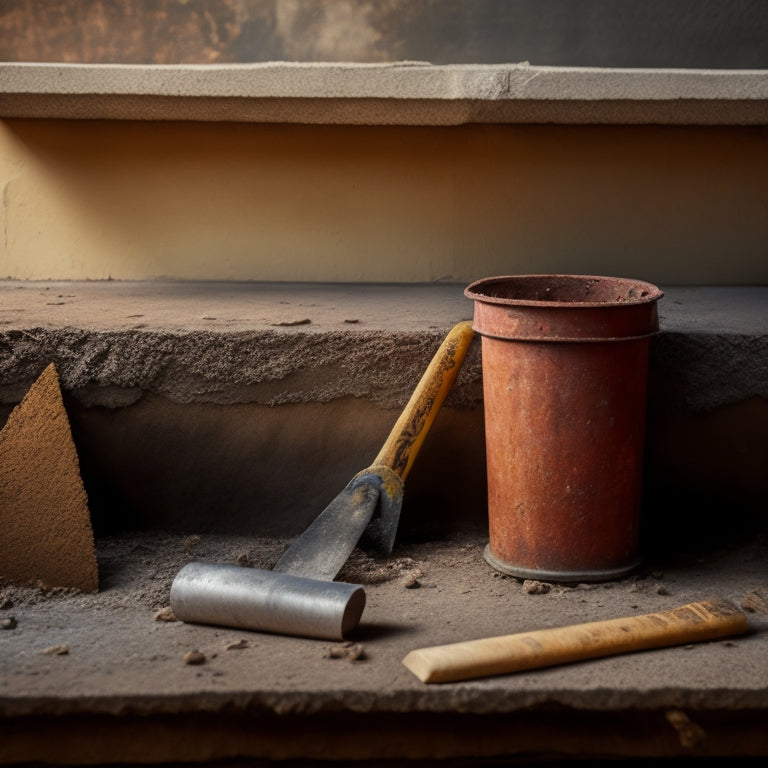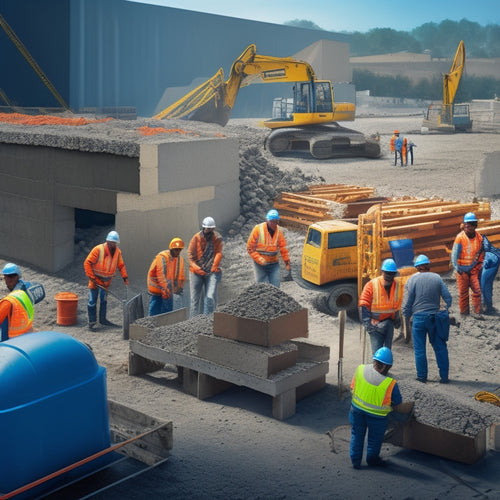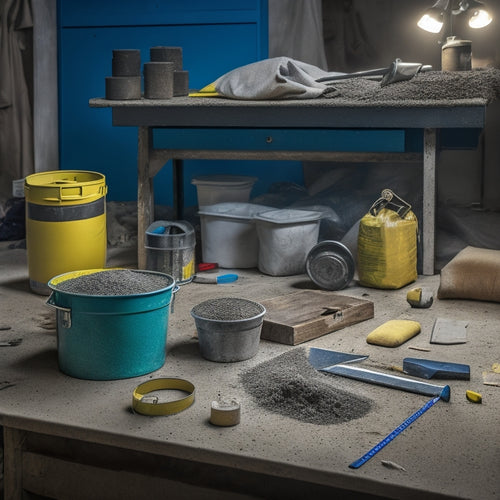
Essential Tools for Repairing Concrete Block Walls
Share
When repairing a concrete block wall, you'll need a well-stocked toolkit to guarantee a successful and long-lasting repair. Essential tools include trowels for smoothing, filling, and finishing touches; chisels for removing loose debris; hammers for tapping and breaking; safety gear like goggles, gloves, and masks; measuring tools for accurate repair; cleaning solutions for surface preparation; mixers for concrete patching compound; and curing compounds for sealing cracks. Having the right tools will make all the difference between an amateurish fix and a professional-looking result. By outlining your toolkit and understanding their roles, you'll be well-equipped to tackle even the most challenging repairs.
Key Takeaways
• A variety of trowels, including pointed, square-edged, notched, and pointing trowels, are necessary for different tasks in concrete block wall repair.
• Chisels, such as point, flat, claw, and scaling chisels, are used to remove loose debris without damaging the concrete.
• Hammers, including ball-peen, claw, and rubber mallets, are essential for tapping, breaking, and shaping concrete during repairs.
• Safety gear, including safety goggles, protective gloves, dust masks, and steel-toed boots, is crucial for protecting oneself from injuries during repairs.
• Measuring tools, such as levels, plumb checks, and laser levels, ensure accurate repair work by confirming wall alignment and detecting deviations.
Trowels for Smoothing and Filling
You'll need a variety of trowels in different sizes and shapes to smooth and fill gaps in concrete block walls, as each one is suited for a specific task. For instance, a pointed trowel is ideal for filling small gaps and corners, while a square-edged trowel is better suited for smoothing large areas. You'll also need a notched trowel for applying and spreading mortar or concrete.
Mastering various trowel techniques is essential for achieving a professional finish. You'll need to learn how to hold the trowel at the correct angle, apply the right amount of pressure, and use a gentle sweeping motion to smooth out the surface. Additionally, you should practice different trowel strokes, such as the 'push-pull' and 'sweep-flick' techniques, to achieve a smooth and even finish.
Chisels for Removing Loose Debris
Once you've smoothed and filled gaps in your concrete block wall, it's time to remove any loose debris that may be obstructing the repair process. That's where chisels come in. Chisels are essential tools for debris removal, allowing you to precision-remove unwanted material without damaging the surrounding concrete.
When it comes to chisel types, you'll want to have the following in your toolkit:
-
Point chisel: Ideal for removing small, stubborn debris and breaking up loose concrete.
-
Flat chisel: Perfect for scraping away larger areas of debris and old mortar.
-
Claw chisel: Great for pulling out larger chunks of debris and old concrete.
- Scaling chisel: Designed for removing heavy layers of old mortar and debris.
Remember to always use the correct chisel type for the specific debris removal task at hand. Strike the chisel with a controlled, gentle motion to avoid damaging the surrounding concrete.
Hammers for Tapping and Breaking
Tapping and breaking concrete block walls require a specific type of hammer that can deliver controlled force without causing unnecessary damage. You'll need a hammer that can absorb shock, reduce vibration, and provide a concentrated impact.
There are several hammer types to take into account, including ball-peen, claw, and rubber mallets. Ball-peen hammers are ideal for tapping and shaping, while claw hammers are better suited for breaking and demolition. Rubber mallets, on the other hand, provide a softer, more controlled impact.
Mastering impact techniques is vital when working with concrete block walls. You'll need to develop a rhythmic, controlled motion to avoid applying too much force. Start with a gentle tap, gradually increasing the force as needed.
It's important to maintain a firm grip and keep your wrists straight to reduce fatigue and prevent injury. Practice different grip styles, such as the 'hammer grip' or 'palm grip,' to find what works best for you.
Safety Gear for Protection
Protecting yourself from the hazards associated with concrete block wall repairs is essential, and wearing the right safety gear is crucial to preventing injuries and ensuring a successful project. You'll be working with heavy blocks, mortar, and potentially hazardous materials, so it's important to take necessary precautions.
Here are the essential safety gear items you'll need:
-
Safety goggles: Protect your eyes from debris, dust, and chemical splashes with a pair of sturdy safety goggles.
-
Protective gloves: Choose gloves that are puncture-resistant, waterproof, and provide grip to prevent slipping and falling.
-
Dust mask: A dust mask will prevent inhalation of harmful particles and dust when working with concrete blocks and mortar.
- Steel-toed boots: Wear boots with a steel toe cap to protect your feet from heavy objects and tools.
Measuring Tools for Accurate Repair
When repairing concrete block walls, you'll need to guarantee that your repairs are straight, level, and plumb.
To achieve this, you'll rely on measuring tools that provide accurate readings and help you identify any deviations from the norm.
Level and Plumb Check
You'll need to conduct a level and plumb check to confirm the wall is properly aligned before making any repairs. This step is essential, as it guarantees the wall's structural integrity and prevents further damage. To achieve accurate results, you'll need to employ the right leveling techniques and plumb alignment methods.
Here are the vital tools you'll need for a level and plumb check:
-
Spirit level: A high-precision spirit level will help you detect even the slightest deviation from the horizontal or vertical plane.
-
Laser level: This tool projects a level line or plane, allowing you to check the wall's alignment over a larger area.
-
Plumb bob: This simple yet effective tool helps you establish a true vertical line, confirming the wall is perfectly plumb.
- Digital inclinometer: This device measures the angle of inclination, providing precise readings to help you identify any deviations from the desired alignment.
Precise Measurement Methods
To guarantee accurate repairs, take precise measurements of the concrete block wall using specialized tools that provide exact readings, thereby eliminating potential errors.
You'll need a combination of measurement techniques to confirm accuracy importance in your repair process.
Invest in a high-quality digital caliper, which can measure widths, lengths, and thicknesses with precision up to 0.01 mm. This tool is essential for measuring cracks, holes, and other defects in the concrete blocks.
A laser distance meter is another vital tool that allows you to measure distances, heights, and widths quickly and accurately. This device is particularly useful for measuring large areas or hard-to-reach spaces.
Additionally, a precision level and a straightedge can help you measure the wall's surface and detect any deviations from the desired plane.
Don't forget a tape measure, which is still an essential tool for measuring larger areas and verifying the accuracy of your other measurements.
Cleaning Solutions for Surface Prep
Effective surface preparation relies on the strategic application of cleaning solutions that break down dirt, grime, and old coatings, allowing for a strong bond between the concrete block and subsequent repair materials.
You'll want to choose cleaning solutions that effectively remove impurities without damaging the concrete.
When selecting a cleaning solution, consider the following options:
-
Eco-friendly cleaners: Gentle on the environment and the concrete, these cleaners are ideal for removing dirt and grime.
-
Pressure washing: Effective for removing heavy buildup, but be cautious not to damage the concrete or dislodge existing mortar.
-
Mild detergents: Useful for removing dirt and grime, but may not be effective on heavy buildup or old coatings.
- Specialized concrete cleaners: Designed to break down and remove old coatings, oils, and other substances that can interfere with the bonding process.
Remember to always follow the manufacturer's instructions and take necessary safety precautions when working with cleaning solutions.
Mixers for Concrete Patching Compound
When preparing to mix concrete patching compound, selecting the right mixer is essential, as it directly impacts the consistency and quality of the final product.
You'll need to take into account two key factors: mixer types and mixer capacity. There are three primary mixer types: handheld, drill-powered, and electric mixers. Handheld mixers are suitable for small batches, while drill-powered mixers offer more power and versatility. Electric mixers are ideal for large-scale projects, providing high-capacity mixing and efficient blending.
When choosing a mixer, think about the mixer capacity, measured in quarts or liters. A general rule of thumb is to select a mixer with a capacity 1-2 quarts larger than the batch size you're mixing. This guarantees adequate room for material movement and prevents overloading. For example, if you're mixing a 2-quart batch, choose a mixer with a 3-4 quart capacity.
Additionally, look for mixers with adjustable speed controls, ergonomic design, and durable construction to guarantee efficient and comfortable mixing. By selecting the right mixer for your concrete patching compound, you'll achieve a smooth, consistent finish and guarantee a successful repair.
Pointing Trowels for Finishing Touches
When you're finishing up your concrete block wall repair, a pointing trowel is essential for achieving a professional-looking result.
You'll need to choose the right trowel for the job, master the ideal angles and strokes, and keep your tool in top condition to guarantee a smooth, even finish.
Trowel Selection Criteria
You'll need a pointing trowel that accurately fits your hand, allowing for precise control and smooth, even applications of mortar or concrete. A well-chosen trowel will make all the difference in achieving a professional finish.
When selecting a pointing trowel, consider the following key factors:
-
Trowel materials: Look for durable, high-quality materials like stainless steel, carbon steel, or high-impact plastic. These will withstand the rigors of heavy use and resist corrosion.
-
Trowel sizes: Choose a trowel size that suits the scale of your project. Common sizes range from 4 to 12 inches, with smaller trowels ideal for detailed work and larger ones for bigger areas.
-
Handle comfort: Opt for a trowel with a comfortable, non-slip handle that fits your grip. This will reduce fatigue and improve control.
- Blade flexibility: Select a trowel with a blade that's neither too stiff nor too flexible. This will allow for smooth, even applications and precise control.
Trowel Angles and Strokes
To achieve a professional finish, hold your pointing trowel at a 20- to 30-degree angle, with the blade almost parallel to the wall, and use controlled, sweeping strokes to spread and smooth the mortar or concrete. This angle allows you to maintain even pressure and prevents digging into the wall. As you work, keep your wrist firm and use your forearm to generate power, allowing you to maintain consistent strokes.
When using a pointing trowel, it's crucial to master various trowel techniques. For instance, the 'push-pull' stroke is ideal for spreading and smoothing mortar, while the 'sweep' stroke is better suited for feathering out excess material.
The choice of trowel materials also plays a significant role in achieving a flawless finish. Stainless steel or high-carbon steel trowels are ideal for concrete repairs, as they provide the necessary rigidity and durability.
Trowel Maintenance Tips
Regularly clean and inspect your pointing trowel to prevent mortar and concrete buildup, which can affect its performance and compromise the quality of your repair work. A well-maintained trowel is essential for achieving a smooth, even finish.
Here are some trowel maintenance tips to keep in mind:
-
Clean your trowel after each use: Remove any excess mortar or concrete with a wire brush or cloth to prevent buildup.
-
Store your trowel properly: Choose a trowel storage solution that protects your tool from damage and prevents rust, such as a dry storage box or a silicone-coated pouch.
-
Inspect your trowel regularly: Check for signs of wear, such as cracks or corrosion, and replace your trowel if necessary.
- Choose the right trowel material: Select a trowel made from high-quality materials, such as stainless steel or forged steel, that can withstand the demands of concrete repair work.
Curing Compounds for Sealing Cracks
Sealing cracks in concrete block walls with curing compounds is an essential step in preventing water infiltration and further damage.
As you prepare to apply a curing compound, make certain the crack is clean and dry. Remove any debris or old sealant, and scrub the area with a wire brush to guarantee a strong bond. Next, apply the curing compound using the recommended application techniques, such as pouring or spraying. Be sure to follow the manufacturer's instructions for the correct amount and timing of the application.
The curing benefits of these compounds are numerous. They not only seal cracks but also help to strengthen the concrete, reducing the risk of further damage. Additionally, they can improve the appearance of the wall by filling in unsightly cracks and discolorations.
Frequently Asked Questions
Can I Use a Regular Hammer for Repairing Concrete Block Walls?
When tackling concrete block wall repairs, you'll want to choose the right hammer for the job.
A regular hammer mightn't be the best option, as it can cause more damage to the blocks or surrounding mortar.
Instead, consider using a specialized hammer, like a crack hammer or a lump hammer, designed for specific repair techniques.
These hammers will help you achieve precise results and avoid further damage to the wall.
Do I Need to Replace the Entire Wall if It's Severely Damaged?
'A stitch in time saves nine' - timely intervention can save you a fortune in repair costs.
If your concrete block wall is severely damaged, you mightn't need to replace the entire wall. Assess the extent of the damage and identify the root cause.
If the wall's structural integrity is compromised, it's vital to address the issue promptly to guarantee wall stability.
In some cases, repairing or replacing individual blocks might be sufficient, but it's important to consult a professional to determine the best course of action.
How Long Does It Take for Concrete Patching Compound to Dry?
When applying concrete patching compound, you'll need to allow sufficient drying time, which typically ranges from 30 minutes to an hour, depending on the product and environmental conditions.
To guarantee the best results, you'll want to follow proper patching techniques, such as applying thin layers, avoiding over-mixing, and keeping the area clean and dry.
Can I Repair a Concrete Block Wall in Extreme Weather Conditions?
When you're faced with repairing a concrete block wall in extreme weather conditions, you'll need to take into account the temperature effects on your materials.
High temperatures can accelerate drying, while low temperatures can slow it down.
To guarantee a successful repair, choose weather-resistant materials that can withstand the elements.
Make certain to follow the manufacturer's instructions for application in extreme temperatures, and think about using specialized products designed for harsh weather conditions to guarantee a long-lasting repair.
Are There Any Diy-Friendly Alternatives to Professional-Grade Tools?
When seeking DIY-friendly alternatives to professional-grade tools, you'll find budget-friendly options that get the job done.
For instance, you can opt for handheld mixers instead of heavy-duty mixers for mixing mortar.
Additionally, consider using a hammer drill with a masonry bit for drilling into concrete blocks.
These DIY tool options may not be as efficient, but they're suitable for small-scale repairs and won't break the bank.
Conclusion
You've made it to the finish line! With these essential tools in your arsenal, you're now a concrete block wall repair mastermind, capable of tackling even the most challenging cracks and crumbles.
Your walls will be so strong, they'll be able to withstand a category 5 hurricane (okay, maybe not, but you get the idea!).
Seriously, with the right tools, you'll be amazed at how easily you can restore your walls to their former glory.
Related Posts
-

Smart Guide to Buying Used Concrete Hand Tools
You're about to buy used concrete hand tools, and you need to get it right. Dedicate time to identify the tools you n...
-

7 Best Tools for Concrete Block Construction
You'll need a solid foundation, precise cutting, and seamless finishing to guarantee your concrete block construction...
-

Top Mixing Tools for DIY Concrete Block Laying
When it comes to DIY concrete block laying, the right mixing tools are vital for a strong and durable structure. You'...


